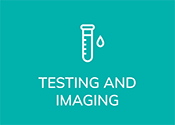
Newly Diagnosed with CLL
Welcome to the club that no one wanted to join. A diagnosis of CLL can be overwhelming. It can be made even more difficult by the need to understand multiple new concepts and to master new medical terminology. Rather than feeling overwhelmed, we recommend that you move slowly and bite off small pieces of the information that you will need to help you. One good thing in CLL is that you will almost always have time to become more expert!
Let’s get you started in the right direction.
3 Steps to Better Decision Making
Don't panic. Get your bearings.
- Watch our Welcome! video.
- Watch one of our webinars for newly diagnosed people with CLL / SLL
- The Importance of Front-Loading Your Knowledge During the Early Journey of CLL / SLL with Dr. Joanna Rhodes
- Just Diagnosed: What Do I Need to Know with Dr. Neil Kay
- Beyond the Diagnosis: Surviving and Thriving with CLL / SLL with Dr. Heather Wolfe
Develop your secret strength. Build your care team.
- Take a deeper dive into building your care team!
Don't go it alone.
- Chronic Lymphocytic Leukemia Disclosure 101: Who, When, and What to Say About Your Diagnosis, Treatment, and Prognosis
Meet Terry Evans, CLL Society’s Director of Support Groups, as he invites you to experience a better way of dealing with your CLL concerns.
Don’t spend another month alone! CLL Society’s approximately 40 support groups nationwide meet virtually once a month. In isolation, we are having conversations with and sharing our CLL worries with only ONE person: ourselves. Experience something better. Outsource your worry and feel the warmth and support of our community. Watch Terry’s video. Don’t let another month go by. Join a CLL-specific support group today.
ADDITIONAL READING
RECENT NEWS
When appropriate, the CLL Society will be posting updates and background information on the present Coronavirus pandemic focusing on reliable primary sources of information and avoiding most of the news that is not directly from reliable medical experts or government and world health agencies.
3 Steps to Better Decision Making
- Watch our Welcome! video.
- Watch Dr. Kay’s excellent video Just Diagnosed: What do I need to know?
 Develop your secret strength. Build your care team.
Develop your secret strength. Build your care team.
- Take a deeper dive into building your care team!
Meet Terry Evans, CLL Society’s Director of Support Groups, as he invites you to experience a better way of dealing with your CLL concerns.
Don’t spend another month alone! CLL Society’s approximately 40 support groups nationwide meet virtually once a month. In isolation, we are having conversations with and sharing our CLL worries with only ONE person: ourselves. Experience something better. Outsource your worry and feel the warmth and support of our community. Watch Terry’s video. Don’t let another month go by. Join a CLL-specific support group today.
ADDITIONAL READING
RECENT NEWS
When appropriate, the CLL Society will be posting updates and background information on the present Coronavirus pandemic focusing on reliable primary sources of information and avoiding most of the news that is not directly from reliable medical experts or government and world health agencies.
















